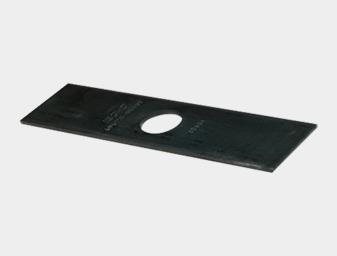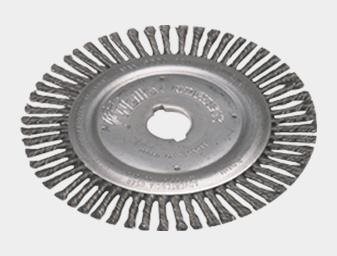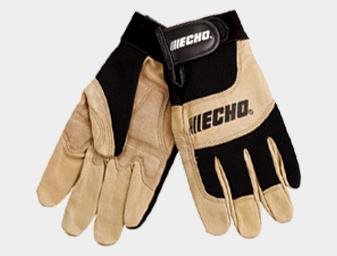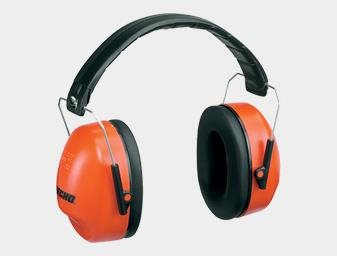How to Use an Edger
A well-manicured lawn is the hallmark of a beautiful home with great curb appeal. Whether you’re a professional landscaper or a Yarder, clean lawn edges instantly transform and elevate any outdoor area. Edging creates distinct, polished boundaries between grass and your walkways, flower beds, or driveway.
A lawn edger is a powerful tool that lets you get precise lines around your lawn’s perimeter. Unlike a standard trimmer, a professional-grade edger has vertical blades or wheels that slice into the soil, resulting in a clear, distinct trench that keeps grass from creeping outside the lines. Whether you use a gas-powered, battery-powered, or electric edger, you can master the art of edging with little practice or know-how—all you really need is the right tools and technique. You can have a lawn that’s the envy of the neighbors.
Read on to learn how to use a lawn edger with our step-by-step guide. We’re sharing everything you need to know about preparing your lawn, using an edger safely, and maintaining your tool so it’s reliable season after season.
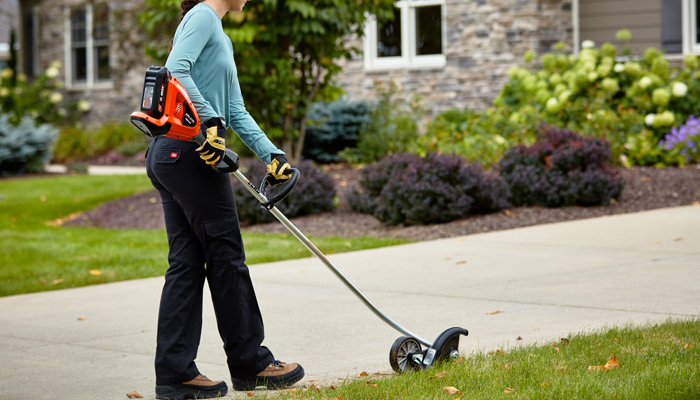
Prepare for Lawn Edging
For best results, it’s essential to prepare your yard before using an edger. Taking the time to prep the area will ensure you get clean lines and can protect your ECHO edger from unnecessary wear during use.
To prepare your lawn for edging, follow the steps below:
- Mow: Mow the entire lawn to a uniform height. This helps you see the perimeter and prevents the grass from being pulled or torn as you edge.
- Clear all debris from the area: Remove any rocks, sticks, branches, or large clippings from the area you’ll be working in. Debris can damage the edger’s blade and poses a risk if it flies at you as you work.
- Water the soil: If necessary, lightly water the entire area. This is especially important if the ground is dry or hard. Moist soil will be much easier to cut through, so you’ll be able to get clean edges without overworking your edger.
- Select the proper edger: Using an edger that’s right for the job is critical. Personal preference comes into play here, too. ECHO offers a range of gas and battery-powered tools that are ideal for any-sized job, whether you’re edging a residential or commercial area.
- Plan your path: Determine your path before you begin. Are you creating new or refreshing existing edges? You can always use a guide, like chalk or a string, to mark the lines if you’re concerned about precision. This can be helpful whether you’re edging a new area, working in a larger space, or using an edger for the first time.
Safety First
Edging your lawn can be rewarding. Seeing the results and admiring the clean lines you create offers a sense of pride. However, like any power tool, safety is important to protect yourself from injury and your tool from misuse. Power edgers are designed and built with safety in mind, but you still need to take proper precautions for a smooth, accident-free experience.
- Wear protective gear every time you use your edger: Safety glasses or goggles protect your eyes and face from flying debris. Gloves, long pants, and closed-toe shoes are also important. Additionally, use ear protection—either earplugs or earmuff-style headphones—to protect your hearing.
- Check for obstructions before working: Before you start working, look for hidden objects, like exposed wires, rocks, or buried utility lines. Any of these can cause damage to your tool and create a safety hazard for you or others as you work.
- Make sure bystanders are far enough away: All pets, children, and others should be far away from the work area when you’re using an edger.
- Use in well-lit conditions: It’s best to edge in the daytime, but if you’re operating an edger in the dusk or evening hours, make sure the area is still well-lit, so you can clearly see and avoid any hazards.
How to Edge a Lawn with an Edger
Once your area is prepped and you’re wearing proper safety gear, you’re ready to put your ECHO edger to work. Learn how to get the job done safely and efficiently—from positioning the edger, to starting it, to getting straight lines, to the finishing touches you want for every job.
Proper Positioning
Positioning is key to maintaining control and getting the clean, straight lines you want when you edge.
Proper positioning means:
- Standing firmly: Stand on firm footing with your feet shoulder-width apart so you feel stable.
- Holding your tool correctly: Grip the edger handles firmly and keep the tool close to your body for better control. This also helps reduce fatigue.
- Aligning the blade: PoPropsition the wheel or blade so it’s just above the ground. Most edgers should be positioned with the blades close to, but not actually touching, the hard surface you’ll be edging along.
- Using the guide wheel: If your edger has a guide wheel, it should rest on a hard surface, like the sidewalk or a driveway. Adjust it so the blade barely touches the ground to maintain a consistent edge depth.
Starting the Edger
Starting an edger isn’t hard, but the steps will depend on whether you’re using a gas- or battery-powered tool. Take a moment to familiarize yourself with the specifics of your model to ensure a smooth start and reliable performance. Using the right procedure helps avoid common issues and keeps your edger in pristine condition.
Gas-powered edgers:
- Check your fuel and oil levels: Before starting any gas-powered tool, make sure you have enough fuel and oil. Never start or operate any type of gas-powered equipment unless you’re outdoors, away from flammable materials, and in a well-ventilated area.
- Prime the engine: To ensure fuel reaches the carburetor, depress the purge pump bulb several times.
- Set the choke: If the engine is cold, verify the choke lever is in the cold-start position.
- Start the engine: As you firmly grip your edger just below the powerhead, pull the starter cord using a fast, firm motion. Repeat as necessary until the engine starts. If this is the first time you're starting the engine for the day—or it's been sitting unused for a while—this is called a 'cold start' and may take a few extra pulls. Once you have the motor running, let your edger warm up before you begin working.
- Engage the blade: Squeeze the blade control to start your cutting action while keeping the engine running.
Battery-powered edgers:
- Charge your battery: The battery in your edger should be fully charged before use.
- Insert the battery: Remove from the charger and attach it to the edger per the manufacturer’s instructions.
- Power your tool on: Turn on your edger and test the blade before you start working.

Edging Tips for Clean, Straight Lines
Getting the professional look you want is easier than you think, especially with a bit of patience and knowledge.
The key to achieving crisp, straight lines is steady movement and correct technique. Let the edger do the work for you. Whether you’re redoing existing lines or creating new ones, the following tips will ensure you get the best results:
- Follow the perimeter: Always start at one end of your lawn and work your way around the perimeter. Use a slow, steady pace and allow the edger to do the work. Don’t force the tool through the soil.
- Use markers for guidance: For the most precision, use stakes and string or a chalk outline to mark the edge you want to create.
- Handle curves and corners: If you’re edging tight curves or corners, slow down. Guide the edger carefully and make multiple passes to get a smooth and even edge.
- Adjust the blade depth: Set the blade depth according to your lawn’s needs. Deeper cuts can be ideal for overgrown edges, whereas shallower cuts are often enough for regular maintenance.
Finishing Touches
Once you’ve finished edging your lawn, a few more simple steps can make a huge difference to achieve a polished look. Take the time to clean up your job. Inspect the work you’ve done to make sure you’re happy with your edges. They should be sharp, crisp, and consistent so they prevent future overgrowth.
To finish your edging job, you can:
- Remove debris: Rake up dirt, grass clippings, or debris the edger left behind.
- Inspect the edges: Walk along your lawn edges to ensure the lines are consistent and free of gaps and uneven spots. Touch up any areas as necessary.
- Reseed any bare spots you find: Edging can accidentally expose bare soil, but you can quickly fix these spots by sprinkling grass seeds on them to encourage new growth and a thick, healthy lawn.
Lawn Edger Maintenance & Storage
Properly caring for and storing your ECHO lawn edger is essential to keeping your tool reliable and ready to work when you are. Regular maintenance extends the life of your edger and helps you avoid costly repairs and downtime. The following simple routines help keep any edger in peak condition, allowing you to get the most out of your investment.
- Cleaning: It’s important to clean your edger after every use. Remove dirt, grass clippings, and any debris from the blade, tool, and air vents. You don’t want buildup to affect performance or cause your tool to overheat.
- Inspecting: It’s also essential to check your edger’s blade regularly for wear and damage. Dull or damaged blades should be sharpened or replaced to ensure you get clean cuts.
- Checking: Check all fasteners and components on your edger. Tighten any loose bolts or screws and look for any signs of excessive wear, like a cracked handle or damaged blades.
- Storing: Properly storing power tools helps them look and perform like new for years to come. Store your edger in a cool, dry, protected area.
FOR GAS-POWERED EDGERS: To prevent gas from gumming up your carburetor, drain any leftover fuel at the end of the season or before storing for an extended period. If you don’t want to drain and replace the gas, you can also use a fuel stabilizer, like Red Armor® Fuel Treatment.
FOR BATTERY-POWERED EDGERS: To prolong the lifespan, remove the battery from your edger before storing it.
- Seasonal considerations: When storing your edger for the off-season, it’s a good idea to lubricate all moving parts and cover your tool to protect it from moisture and dust. Power tools should be out of reach for children and in a well-ventilated area that isn’t exposed to ice, frost, or moisture.
Elevate Your Lawn Care Routine
A well-edged lawn makes a statement. When you incorporate regular edging into your lawn care routine, your landscape will stand out, with clean lawn lines that frame your yard to enhance its overall appeal.
If you’re ready to take your yard and lawn to the next level, explore ECHO’s high-performance lawn edgers and other power tools today. Shop ECHO edgers now.
